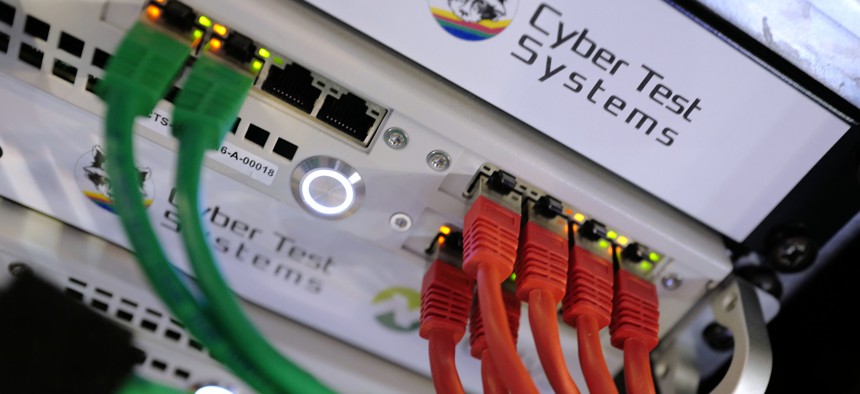State IT Officials Will Push for New Federal Grants to Help With Tech Upgrades

Cables are plugged into servers and computers at an international cybersecurity forum. AP Photo/Michel Spingler
The group that represents chief information officers says the pandemic has highlighted how unemployment systems and other state and local technology need to be modernized.
Improving broadband connections, strengthening cybersecurity, and modernizing legacy information technology systems have long been priorities for the National Association of State Chief Information Officers.
But the coronavirus outbreak has elevated the urgency for state and local governments to address these sorts of longstanding tech challenges. That has state information officers hopeful congressional lawmakers will establish new grant programs to support these efforts in the coming year.
This week, NASCIO outlined its key federal legislative priorities for 2021, noting that collaboration between states and the federal government will be necessary to improve cybersecurity and infrastructure at the local level.
One area of focus will be IT modernization.
Unemployment systems, which many states have not modernized, experienced unprecedented demand last year as millions of Americans lost their jobs during the coronavirus pandemic. The surge in benefit claims quickly stretched many systems to the max and underscored the importance of IT modernization, said Matt Pincus, NASCIO’s director of government affairs.
“There is this recognition that the federal government needs to make sure states are delivering federal programs and benefits, such as UI, to citizens in a secure and timely manner,” Pincus said. “A lot of systems were not able to handle a 1,500% increase in traffic.”
To improve state IT infrastructure, NASCIO is urging Congress to establish a grant program that would give state and local governments money to pay for the transition away from legacy systems to modern platforms.
Pincus pointed to the State and Local IT Modernization and Cybersecurity Act, introduced last Congress, as one such solution. The bill would have established a $25 billion grant fund, plenty of funding for state chief information officers to get improvements underway, he said.
NASCIO is also pushing for Congress to provide additional funding for cybersecurity upgrades in state information technology offices.
Cybersecurity was at the forefront of IT professionals’ concerns in 2019 as ransomware attacks on state and local governments proliferated. But even as cybersecurity concerns have grown during the pandemic with government employees working remotely, at least half of states allocate less than 3% of their total information technology budgets to cybersecurity.
Last year, the House and Senate passed separate bills they were unable to reconcile that would have provided cybersecurity grant funding for local governments. Some proposals would have the Federal Emergency Management Agency administer the grants while others gave the Cybersecurity and Infrastructure Security Agency the responsibility.
Pincus said NASCIO is hopeful federal lawmakers will be able to reach a deal on a grant funding program this year and can then work out the details of how much financial aid would be needed.
NASCIO’s other legislative priorities for the upcoming year include streamlining federal cybersecurity regulations and improving broadband accessibility.
Andrea Noble is a staff correspondent with Route Fifty.
NEXT STORY: The risks of DDoS attacks for the public sector





